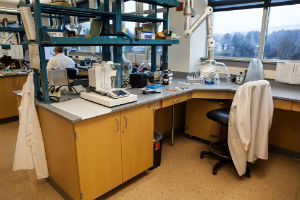The Drug Chemists at the Vermont Forensic Laboratory perform tests to determine if regulated/controlled substances are present in plant material, powders, tablets, residues and liquids submitted by Vermont law enforcement officers and investigators. In many cases, these items are illegal drugs or prescription drugs stolen or diverted for abuse purposes. In other cases the specimens are suspected poisons or contaminants.
The analysis of plants suspected of being marijuana involves microscopic/macroscopic examination and Chromatography. By observing the plant under magnification, the Forensic Chemist is able to identify characteristics consistent with marijuana. A few of these characteristics include cystolythic hairs (bear claws), thick walled conical trichomes, glandular hairs and fluted stems. A second test involving chromatography (Thin layer Chromatography or Gas Chromatography/Mass Spectrometry) on the plant material is performed to identify if the active ingredient of marijuana is present (delta-9-THC). Marijuana is often submitted in various forms (leaves, buds, hand-rolled cigarettes, residue, hash, oil, added to food products, etc).
Unknown powders, liquids, tablets, liquids and residues undergo a different type of analysis. Typically, these substances are first analyzed using color spot tests. These simple chemical tests help the chemist by providing an initial "presumptive" identification of the unknown substance, to be followed by other more sophisticated and informative types of testing. Our procedural guidelines dictate that all drug identifications utilize another method of analysis, particularly one that provides information about the chemical structure of the compound. Our methods of structural identification include Gas Chromatography/ Mass Spectrometry (GC/MS) and/or Fourier Transform Infrared Spectrophotometry (FTIR).


